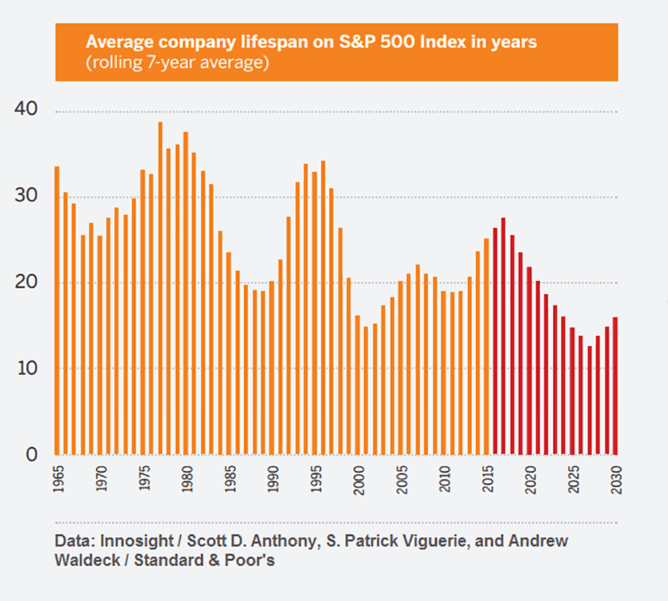Spend your whole career at one company, get a Rolex when you retire, and enjoy your golden years by drawing off your substantial pension. We know this scenario is rare or even non-existent in today’s world. Employees change jobs much more frequently now, and this has become more acceptable – even preferable – rather than having had only one or two employers. A recent Forbes article states that by 2020, 50% of the U.S. workforce will be freelancers. Short-term loyalty has seemingly become the norm and long-term loyalty has become a sign of staleness, irrelevance.
 This short-term phenomenon has effects well beyond the individual employee – business lifespans are becoming shorter, too. According to Standard & Poor’s, since 1950 the average life cycle of a company has been reduced from 60 years to 15 (see chart below) and precipitous lifespan declines will continue through 2027, possibly beyond.
This short-term phenomenon has effects well beyond the individual employee – business lifespans are becoming shorter, too. According to Standard & Poor’s, since 1950 the average life cycle of a company has been reduced from 60 years to 15 (see chart below) and precipitous lifespan declines will continue through 2027, possibly beyond.
With organizations and employees both leaning toward short-term commitments rather than the long view, how can companies structure themselves to maintain stability and a healthy bottom line? Businesses are beginning to experiment with different organizational structures to adapt.
Self-management is becoming the answer for some open-minded companies, signaling a radical departure from the typical hierarchical manager. Tomato processing company Morning Star is seeing successful results from self-management and others will too, according to Josh Allan Dykstra, a vocal visionary who sees the transformation that self-management is catalyzing among businesses.
In the Huffington Post, Josh wrote “Why Self-Management Will Soon Replace Management” saying: “In self-management, the ‘structures’ are generally sets of principles that elicit (or prohibit) certain kinds of behaviors. At Morning Star, for example, the entire organization is built on two principles: 1) No one has power or coercion over anyone else, and 2) People must keep their commitments to each other. There are other rules, of course, but with very little effort one can see how a foundational adoption of even just these two principles would drastically reshape the mindset of a traditional organization.”
If self-management dictates that employees need to keep their commitments to each other, then technology can help facilitate this. Organizations need to make data and core functions “omni-accessible” for their knowledge professionals who are not necessarily limited by geographic location or office hours. Universal cloud-based access to data and documents allows employees to function on a level playing field where information is available at any time.
Organizations accrue large masses of information that can then be transformed into knowledge and analytics to benefit all. If companies could break down silos separating this analytical information, they could leverage the full power of predictive analytics to improve both internal and external processes. The applications of predictive analytical data are infinite, from accounts payable to H.R. just to name a few. An end-to-end automated solution will have these capabilities built into its blueprint, meaning you can harness all the data available to further the mission of your business.
The pace of work is getting faster. Company and employee tenures are getting shorter. Management responsibility is gradually shifting to the individual employee. In the midst of these paradigm shifts, technology and automation can provide consistency, stability, and predictability. Navigating these waters carefully will result in a higher likelihood that your business’s lifespan will be longer and more successful.

